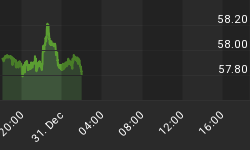The "dumb money" sentiment indicator remains neutral on the equity markets, and the "smart money" has turned more bearish. It should be noted that this is the sixth week in a row where the "dumb money" is neutral, and this is not a scenario that is generally supportive of higher prices especially with prices on the S&P500 under their 40 week moving average. The ideal situation for higher equity prices would be for the "smart money" to be bullish and the "dumb money" bearish (i.e., bull signal).
The "dumb money" or investment sentiment composite indicator (see figure 1, a weekly chart of the S&P500) looks for extremes in the data from 4 different groups of investors who historically have been wrong on the market: 1) Investor Intelligence; 2) Market Vane; 3) American Association of Individual Investors; and 4) the put call ratio.
Figure 1. "Dumb Money"
The "smart money" (see figure 2) refers to those investors and traders who make their living in the markets. Supposedly they are in the know, and we should follow their every move. The "smart money" indicator is a composite of the following data: 1) public to specialist short ratio; 2) specialist short to total short ratio; 3) SP100 option traders.
Figure 2. "Smart Money"
For the past 3 weeks it has been the same story: sell hope and buy fear. If the "dumb money" indicator is any gauge, it appears that market participants are caught on the wrong side of the trend. This week the bulls remain hopeful of a post inaugural rally, but even if it does materialize, the correct course of action for those with a trading mindset is to sell strength. I define what I mean by "strength" in the article, "Investor Sentiment: Some Context".
From my perspective, it is likely that the November lows will be tested and possibly violated. This is another way of saying, "we need more bears" before the market can go higher, and this means the "dumb money" indicator needs to turn bearish (i.e., bull signal) before a multi week trade is likely to develop.
Finally, it should be noted that the "smart money" has been bearish for 8 out of the last 9 weeks. In 18 years of data and in over 45 signals, the "smart money" has confirmed the "dumb money"in over 95% of the cases. By this I mean, we need to see the "smart money" turn bullish as a confirmation of the "dumb money" turning bearish. Typically, lower prices will make the "smart money" turn bullish.
















